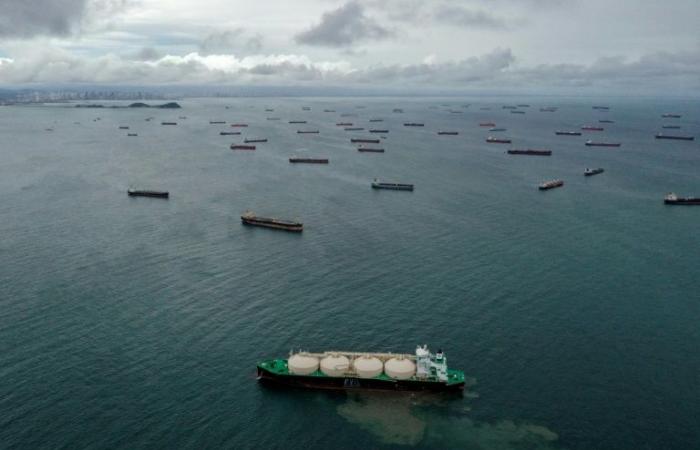Those who expected a brief disruption before returning to normal were quickly disappointed. Day after day, the drought is taking a heavy toll on commercial traffic on the strategic Panama Canal, through which nearly 6% of world maritime trade passes.
The canal is suffering from an unprecedented water crisis. As water levels continue to drop, authorities in Panama expect losses of as much as $700 million this year.
The water problem in the Panama Canal is certainly not new, but this is the first time that the canal authority has been forced to reduce daily transit after the level of Gatun Lake, an artificial body of water in Panama City that feeds the canal, shrank to the point that it is no longer sufficient to meet the usual capacity of the canal. 38 ships per day.
The Panama Canal… at the mercy of nature
Restrictions on the transit of ships have led to bottlenecks, delays, increased transport costs and uncertainties about the future of the canal, which this year celebrates the 110th anniversary of its inauguration.
A study published in the international scientific journal “Nature” warns that the planet will experience “more severe drought conditions such as those experienced in Panama as a result of the El Niño phenomenon associated with an increase in the temperature of the Pacific Ocean, or periods of heavy rains, which will affect around 3 billion people. In a less optimistic scenario, this number could reach 5 billion (66% of the world’s population) by the end of the century.”
In terms of numbers, consumers have already felt the inflationary impact of the situation in the Panama Canal since the middle of last year, since 40% of container shipping traffic to the United States transits through the canal, which is used as an alternative to the road and rail network that connects the two coasts of the vast territory of the world’s largest economy. The situation has caused a surge in the price of goods in an economic context marked by an increase in the cost of living.
According to Nature magazine, each container costs shipping companies around 8.000 dollarsand each delay puts further pressure on the price of goods. As international shipping companies look for alternatives, the problem is getting worse as the delay in finding a solution continues.
Although the Panamanian government has invested around five billion dollars to widen the canal and allow larger ships to enter, climatic hazards create more surprises.
Climate change…a major challenge for global trade
Climate change is a real challenge for global trade. In addition to geopolitical tensions that are increasing near some important transit points, problems of drought, falling water levels and global warming are creating major challenges for vital trade that affects the daily lives of millions of people around the world.
Roberto Durán, professor and researcher at the Faculty of Sciences of the Monterrey Institute of Technology in Mexico, believes that in light of the difficulty of controlling climate fluctuations, there are viable alternatives such as improving the railway and road system in the United States or the implementation of the interoceanic corridor of the Isthmus of Tehuantepec. It connects the Atlantic Ocean (Gulf of Mexico) to the Pacific Ocean (Gulf of Tehuantepec) through the ports of Coatzacoalcos and Salina Cruz.
The expert believes that the difficulties of the Panama Canal generate a “triple crise”starting with the health dimension following the outbreak of the Covid-19 pandemic and the closure of borders, the geopolitical conflict in the Middle East, where many vital shipping routes are located, and finally the climate problem.
Many shipping companies have begun to transit through the Suez Canal to reach the United States via the East Coast to avoid the delays or customs fees associated with crossing Panama, but this alternative comes with higher costs and more time.
The Panama Canal Administration has just announced an increase in daily transit traffic of ships to 35 starting August 5, following recent heavy rainfall.
On average, daily traffic through the canal between the Atlantic and Pacific Oceans is between 35 and 36 ships, but the severe drought has reduced movements to 20 and then 22, without reaching the worst-case scenario of 18 ships per day.
Restrictions on transit since the middle of last year threaten to cause a drop in the canal’s revenues from fees, $800 million during the current financial year.
The Panamanian Waterway serves more than 180 maritime routes connecting 170 countries and reaching approximately 1,920 ports worldwide.
Revenues generated by international trade in the Panama Canal are making a record contribution to the country’s public treasury, exceeding two billion dollars in 2023.
(With MAP)
Do you have a real estate project in mind? Yakeey & Médias24 help you make it happen!
© Médias24. Any reproduction prohibited, in any form whatsoever, without the written permission of the Société des Nouveaux Médias. This content is protected by law and in particular law 88-13 relating to the press and publishing as well as laws 66.19 and 2-00 relating to copyright and related rights.
Yes But
July 2, 2024 at 1:33 p.m.
Modified July 2, 2024 at 1:33 p.m.






